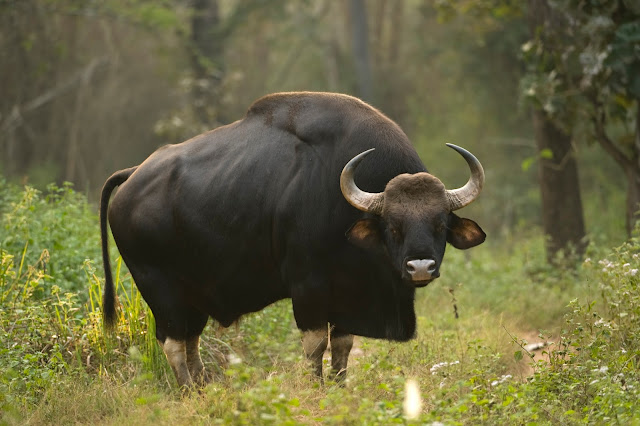Indian Black Bear
Now go for "The Papa Balu"
Time for a safari for Indian Black Bear.
- In The Jungle Book, we saw a lazy, big, honey eater Bear; name is "Balu". It is non other than "Indian Black Bear".
Introduction Part
- Indian Black Bear or Asiatic Black Bear or Moon Bear or Tibetan Bear Or Himalayan Black Bear is a medium sized bear existing in India and other parts of Asia.
- It falls under the family Ursidae with the scientific name as Ursus thibetanus.
Physical Characteristics
- The Indian Black Bears are the medium sized bears with long black coloured fur over its body.
- They are characterized with a white or cream coloured V- shaped patch on its chest and whitish chin. They possess long and thick hair on the neck and shoulders.
- Bears have a roundish head with big ears. Their forelimbs and claws are sharp such that they help them to climb trees but their hind limbs are weak.
- They are efficient climbers and live on trees most of the time. Unlike American black bears, they are aggressive towards humans by killing and attacking them.
- Indian Black Bears are also known as bipedal walking. They have a poor vision and the hearing sense is moderate. Like other animals, males are larger than females.
- These bears are 50-165 centimetre tall at the shoulders. The male weights about 50 to 120 kg whereas female weights 40-70 kg. Their body length is about 1 to 1.5 meter and a tail is about 6 to 11 cm long.
Population of Black Bear in India
- The accurate population estimate is unknown, but the rough analysis has shown that around 7000-20,000 bears exist in various parts of India.
- Name of state Population (per km2)
- Jammu & Kashmir 1104
- Himachal Pradesh 3057
- Uttar Pradesh 5374
- West Bengal 964
- Sikkim 1707
- Arunachal Pradesh 5304
- Meghalaya 249
- Mizoram 580
- Tripura 01
Food Habits
- Indian Black Bears are omnivorous feeding on both animals and plants. They eat various varieties of food like fruits, buds, nuts, seeds, honey, herbs, cherries, acorns, dog wood, grain, grasses, leaves, oak nuts and other fat rich food.
- Their prey includes wild boar, muntjacs, water buffalos and insects like termites, beetle eggs, birds, fish, molluscs. At times they attack the live stock like sheep, goats and cattle.
Conservation effort in India
- Indian Wild Life Protection Act 2003 has taken steps to protect the bears by establishing protected areas in many of the parks which would prevent reduction in habitat loss, food loss, poaching and other threats.
- International Union for the Conservation of Nature and Natural Resources (IUCN) has classified Asian Black Bear As "Vulnerable" species. Convention on International Trade in Endangered species of Wild Fauna and Flora (CITES) has taken steps to protect bears from trade.
Interesting Facts about Black Bear
- The gall bladder or bile of Asiatic Black Bear has an excellent medicinal purpose and it has been a demand in the market.
- Asian Black Bear possess very sharp, hooked claws which help them to eat and climb trees.
- They are usually nocturnal, but diurnal depending on their habitat.





ReplyDeleteAsian Black Bear Animal Images HD Photos Gallery
This blog is very helpful and informative for this particular topic. I appreciate your effort that has been taken to write this blog for us. Dog Wood Kennel Usa
ReplyDelete